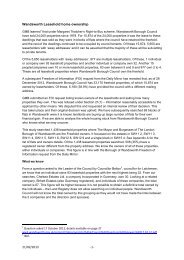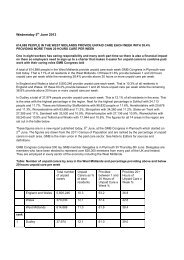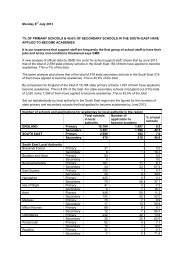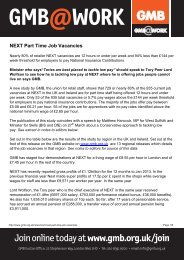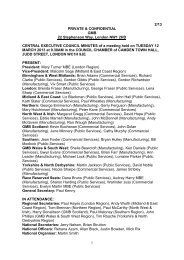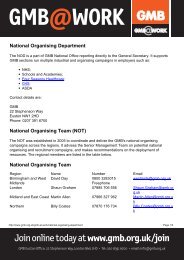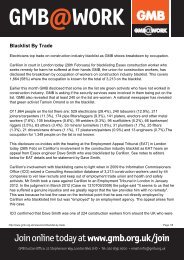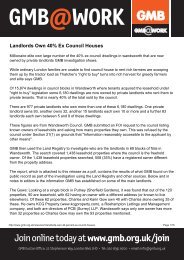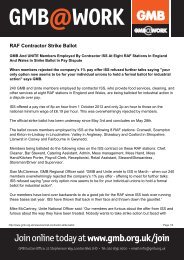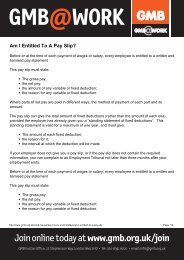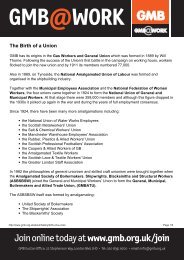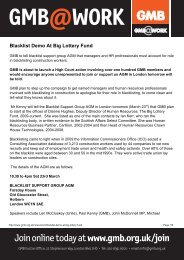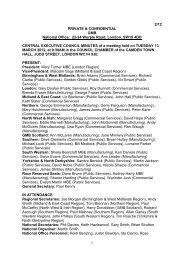Inspection Checklist - GMB
Inspection Checklist - GMB
Inspection Checklist - GMB
Create successful ePaper yourself
Turn your PDF publications into a flip-book with our unique Google optimized e-Paper software.
Health&Safety<br />
<strong>Inspection</strong><br />
<strong>Checklist</strong><br />
Please photocopy before use
How to use<br />
this checklist<br />
Safety reps have extensive legal rights to carry<br />
out inspections of the workplace. It is important<br />
for <strong>GMB</strong> Safety Reps to exercise this right and<br />
undertake regular inspections. Inspecting the<br />
workplace allows you to meet your members and<br />
discuss their concerns. This shows that you are<br />
serious about tackling the health and safety issues<br />
which affect them and helps to maintain the<br />
<strong>GMB</strong>’s profile. For full details of when you are<br />
entitled to inspect see Section Six of the<br />
<strong>GMB</strong> Safety Reps Handbook.<br />
This checklist is designed to help Safety Reps carry<br />
out workplace inspections. Its aim is to help you<br />
cover some of the most important areas and<br />
consider what improvements need to be made.<br />
Some of the questions may not apply to your<br />
particular workplace and some new ones may need<br />
to be added. The best checklists are those<br />
developed by Safety Reps using their knowledge<br />
and experience of their workplace. Use this<br />
checklist as a basis for developing one of your own,<br />
amending it where necessary to suit your needs.<br />
The checklist will not solve your problems,but it is a<br />
tool for identifying the priority areas for<br />
improvements. Carry out regular inspections and<br />
use your checklist each time you do so. Check the<br />
accident book before you inspect to find out details<br />
of any accidents which may have occurred. When<br />
you are on your rounds,communicate with your<br />
members. Listen to what they have to say and take<br />
note of their suggestions for improvements.<br />
Conducting short surveys amongst your<br />
membership can also provide useful information on<br />
their common problems and concerns.<br />
1 Photocopy this checklist to use as the basis of your own customised<br />
version. Add items which are relevant to your particular workplace on<br />
additional sheets of paper,based upon the list on the back page. You will<br />
need to develop your own questions for these areas. The question already<br />
listed on the following pages cover a number of basic areas only,although<br />
many of them will apply to most workplaces. Drawing up your own<br />
customised version will allow you to ask the questions which you want to<br />
about health and safety in your workplace. This way you will have a<br />
checklist which suits your needs. You do not have to cover all the areas<br />
listed,so ignore anything on the checklist which doesn’t apply.<br />
2 Decide which works areas are to be inspected. If you work in a small<br />
establishment it may be appropriate to check the whole area. In the case<br />
of a larger establishment,particular workplaces or sections can be<br />
inspected separately.<br />
3 As you inspect,work through the questions on your checklist and decide<br />
which measures need to be taken according the following procedure:<br />
a) If action is not needed(ie improvements have already been carried out or<br />
the inspection has found the area to be safe)tick the NO ACTION column<br />
opposite the relevant question.<br />
b) If improvements are needed tick the ACTION column. The ACTION column<br />
should also be ticked if measures have already been taken but further<br />
action is necessary.<br />
c) If urgent action is necessary tick the URGENT ACTION column.<br />
d) In the COMMENTS section,write your notes on the action which needs to<br />
be taken. You may need extra paper to take notes whilst carrying out your<br />
inspection.<br />
4 After the inspection,insure that management is informed of the problems<br />
and take appropriate action to resolve them. Always make your reports in<br />
writing using your <strong>GMB</strong> Safety Representatives Report Forms. See Sections<br />
Six and Seven of the <strong>GMB</strong> Safety Reps Handbook for more information on<br />
action after the inspection and resolving problems.Keep a record of the<br />
date,the area(s)inspected and a copy of the checklist for your records.<br />
Use your copy to check that management have taken the appropriate<br />
action.
LIGHTING<br />
Are all areas of the workplace,including relevant outside areas<br />
adequately lit?<br />
NO<br />
URGENT<br />
ACTION ACTION ACTION COMMENTS<br />
Have excessive glare and reflections have been eliminated?<br />
Are workstations properly positioned to make the best use of natural<br />
light?<br />
Is local lighting provided to workstations where necessary?<br />
Is emergency lighting provided,with an independent power source<br />
which activates automatically when normal lighting fails?<br />
Does emergency lighting provide enough light?<br />
NOISE<br />
Is the workplace too noisy?<br />
Is noise reduced at source by the provision of properly designed,well<br />
maintained and adjusted tools or machines?<br />
Are noise levels reduced by the use of sound-absorbent materials?<br />
Can the source of any excessive noise be enclosed or isolated?<br />
Is suitable hearing protection provided if noise levels cannot be<br />
reduced by any other means?<br />
TEMPERATURE,VENTILATION&EXTRACTION<br />
Is the workplace too hot or too cold?<br />
Can measures be taken to control temperature extremes?<br />
Is there enough natural ventilation in the workplace,eg windows or<br />
open doorways?<br />
If natural ventilation is insufficient,are ventilators,fans or air<br />
conditioners provided to ensure a consistent flow of fresh air?<br />
Is machinery and equipment which generates heat or fumes isolated or<br />
enclosed?<br />
Are adequate extraction systems fitted to machinery or equipment,or<br />
is local exhaust ventilation provided where necessary?<br />
Are ventilation and extraction systems regularly cleaned and<br />
maintained to ensure their efficiency?<br />
HOUSEKEEPING&WASTE MATERIALS<br />
Is the workplace kept generally clean and tidy?<br />
Are appropriate and convenient storage racks provided for tools,raw<br />
materials,parts and products?<br />
Are oil spills and other‘slips,trips and falls’hazards promptly cleaned<br />
up or removed?<br />
Are all work areas cleaned and tidied up daily(or more frequently if<br />
necessary),with all hazardous waste materials disposed of properly?<br />
Are there enough waste receptacles or containers of adequate size?<br />
Is there provision for proper drainage of waste water or other liquids?
TRAFFIC ROUTE&PASSAGEWAYS<br />
Are there separate routes for pedestrians and traffic(eg fork lift<br />
trucks,etc)in the workplace?<br />
NO<br />
URGENT<br />
ACTION ACTION ACTION COMMENTS<br />
Are aisles,passageways and traffic routes free from obstructions and<br />
other hazards,and clearly marked for safe movement of people,<br />
vehicles and materials?<br />
Have measures been taken to prevent workers from being struck by<br />
moving materials or vehicles?<br />
Are warning notices,signs or signals posted where hazardous<br />
conditions exist?<br />
Are barriers placed around temporary floor openings,and used to<br />
restrict access to dangerous machines and processes?<br />
Are sharp,dangerous or hot objects removed,or located so that<br />
workers cannot be hurt accidentally?<br />
EMERGENCY EXITS<br />
Are all fire escapes and routes to emergency exit free from obstacles?<br />
Are all emergency escape exits clearly marked?<br />
Are there enough fire extinguishers of the correct type within easy<br />
reach and near each exit?<br />
Have workers been instructed in the evacuation procedures in the<br />
event of an emergency?<br />
FALLS OR FALLING OBJECTS<br />
Are all staircases secure and fitted with suitable handrails?<br />
Are ladders,platforms,crawling boards and other equipment for<br />
working at heights in good repair and suitable for the task?<br />
Are all fragile roofs and surfaces clearly identified?<br />
Have measures been taken to prevent falls into vessels containing<br />
dangerous substances?<br />
Are materials and objects adequately stored or stacked to prevent<br />
them from falling and causing injury?<br />
Are vehicles unloaded safely,without workers having to climb on top<br />
vehicles or loads?<br />
ELECTRICAL SAFETY<br />
Are there any exposed,loose or entangled wires or connections?<br />
Are all switchboxes,panel boards and sockets provided with suitable<br />
covers?<br />
Is all electrical equipment effectively earthed?<br />
Is all electrical equipment regularly inspected for signs of wear and<br />
tear?
HAZARDOUS SUBSTANCES<br />
Have all substances used in the workplace been assessed and<br />
adequately controlled under the COSHH Regulations?<br />
NO<br />
URGENT<br />
ACTION ACTION ACTION COMMENTS<br />
Have safer materials and substances been substituted where<br />
possible?<br />
Are dust or fume producing machines enclosed or isolated?<br />
Are sources of hazardous gases or vapours completely enclosed or<br />
sealed?<br />
Is local exhaust ventilation adequate? Is it regularly cleaned and<br />
maintained?<br />
Is suitable protective equipment provided where exposure cannot be<br />
controlled by other means?<br />
HANDLING HAZARDOUS MATERIALS<br />
Is work organised to eliminate or minimise the handling of hazardous<br />
materials?<br />
Where direct handling is unavoidable,are workers provided with<br />
suitable personal protective equipment,clothing and gloves?<br />
Are there emergency procedures and facilities for dealing with<br />
chemical spillages and other accidents?<br />
Are all hazardous substances and materials properly labelled?<br />
Is suitable protective equipment provided with the full information,<br />
instruction and training on the hazards of the materials?<br />
PROTECTIVE EQUIPMENT<br />
Has the need to use personal protective equipment been minimised by<br />
the introduction of other risk control measures?<br />
Is the protective equipment provided(eg safety glasses,face shields,<br />
masks,ear defenders, safety footwear,helmets,gloves,etc)suitable<br />
for the task?<br />
Has all protective equipment which is used only at work been provided<br />
at no cost to the worker?<br />
Is all protective equipment in good condition and well maintained?<br />
Have all workers who use personal protective equipment been<br />
provided with full information on the risks they are being protected<br />
from,and given instruction and training on proper use of the<br />
equipment?
MACHINE SAFETY<br />
Are all moving parts of machines and equipment fitted with<br />
appropriate guards?<br />
NO<br />
URGENT<br />
ACTION ACTION ACTION COMMENTS<br />
Are all machinery guards securely fastened to the machines?<br />
Do machines have safety cut-out switches or other safety devices to<br />
prevent the operation of machines while workers’hands are in danger?<br />
Can emergency stop controls be easily reached by all machine<br />
operators?<br />
Are safety devices and controls regularly checked,and the machines<br />
properly maintained to ensure safe working?<br />
Is maintenance work carried out safely,and machinery maintenance<br />
logs kept up to date?<br />
TOOLS&EQUIPMENT<br />
Are tools and work equipment suitable for the job?<br />
Are tools of appropriate size,and shaped for easy and safe use?<br />
Are locking devices(or similar)fitted to tools to reduce gripping or<br />
handling force and vibration?<br />
Are all tolls and equipment kept in good repair and properly<br />
maintained?<br />
Has the location where the equipment or tools are being used been<br />
assessed to identify any particular risks which may arise? For<br />
example,working in confined spaces or a flammable atmosphere?<br />
Is training provided for those who use tools and work equipment,and<br />
also for their managers and supervisors?<br />
LIFTING&HANDLING<br />
Have all work tasks been assessed to determine whether the handling<br />
of loads can be avoided altogether?<br />
Have manual handling assessments taken account of factors other<br />
than weight,such as the size and shape of the load and the condition<br />
of the work environment?<br />
Is mechanical equipment,such as lever,conveyors,vacuum lifters,<br />
cranes,lift trucks and trolleys used to avoid manual handling?<br />
Can the load be altered(for example,by reducing the size or weitht or<br />
providing handles)to reduce the risk of injury?<br />
Are workers properly trained in lifting and other manual handling<br />
techniques?
WORK DESIGN<br />
Does the layout of working surfaces,controls and equipment cause<br />
workers to bend,stretch or adopt awkward postures?<br />
NO<br />
URGENT<br />
ACTION ACTION ACTION COMMENTS<br />
Are footstands or platforms provided for standing workers to avoid the<br />
need to work with raised hands or arms?<br />
Are workbenches or tables for seated workers positioned at the<br />
correct height to avoid awkward hand and are positions?<br />
Are frequently operated switches and controls easily distinguishable<br />
from each other by clearly identified sizes,shapes,colours and<br />
positions?<br />
Are all racks,storage bins and materials within easy reach of workers?<br />
SEATING<br />
Could work which is carried out standing be done just as well whilst<br />
seated?<br />
Are all seats individually adjustable to suit the height of the work<br />
surface and posture of the worker,and are footrests provided when<br />
necessary?<br />
Are seats in good condition,with comfortable surfaces and cushions?<br />
Do chairs have correctly sizd and positioned backrests to provide<br />
lower back support?<br />
FIRST AID FACILITIES<br />
Is there at least one fully equipped first iad box provided in all<br />
workplaces?<br />
Where necessary,is there a first aid room with adequate facilities and<br />
equipment(taking into account the type of work or workplace,the<br />
numbers employed,etc)?<br />
Is there a sufficient number of qualified first-aiders?<br />
Are qualified first-aiders available at all times(on late and night shifts,<br />
for example)?<br />
WORKPLACE FACILITIES<br />
Are there sufficient toilet facilities near to work areas,with separate<br />
hand washing facilities and an adequate supply of hot water,soap or<br />
hand cleaners?<br />
Are toilet and washing facilities regularly cleaned and in a sanitary<br />
condition?<br />
Is a clean locker room provided for changing clothes,with facilities for<br />
separating soiled working clothes from personal clothing?<br />
Is there a comfortable separate room for workers to take rest breaks?<br />
Is there a separate rest room(or area of the rest room)for nonsmokers?<br />
Is there a rest room for pregnant women and nursing mothers,near to<br />
sanitary facilities and with somewhere to lie down?<br />
Is there an adequate supply of fresh drinking water?<br />
Is there a separate,hygienic and comfortable eating area which is<br />
adequate for the numbers employed?



